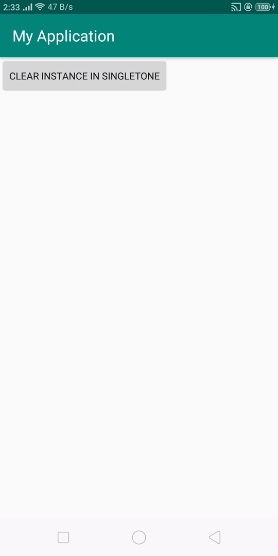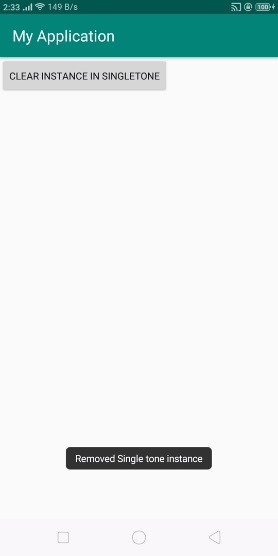
 Data Structure
Data Structure Networking
Networking RDBMS
RDBMS Operating System
Operating System Java
Java MS Excel
MS Excel iOS
iOS HTML
HTML CSS
CSS Android
Android Python
Python C Programming
C Programming C++
C++ C#
C# MongoDB
MongoDB MySQL
MySQL Javascript
Javascript PHP
PHP
- Selected Reading
- UPSC IAS Exams Notes
- Developer's Best Practices
- Questions and Answers
- Effective Resume Writing
- HR Interview Questions
- Computer Glossary
- Who is Who
How to store Hashmap in Singleton in android?
Before getting into an example, we should know what singleton design pattern is. A singleton is a design pattern that restricts the instantiation of a class to only one instance. Notable uses include controlling concurrency and creating a central point of access for an application to access its data store.
This example demonstrates How to store Hashmap in Singleton in android
Step 1 − Create a new project in Android Studio, go to File ⇒ New Project and fill all required details to create a new project.
Step 2 − Add the following code to res/layout/activity_main.xml.
<?xml version = "1.0" encoding = "utf-8"?>
<LinearLayout xmlns:android = "http://schemas.android.com/apk/res/android"
xmlns:tools = "http://schemas.android.com/tools"
android:layout_width = "match_parent"
android:layout_height = "match_parent"
tools:context = ".MainActivity"
android:orientation = "vertical">
<Button
android:id = "@+id/show"
android:text = "Save HashMap in singleTone"
android:layout_width = "wrap_content"
android:layout_height = "wrap_content" />
</LinearLayout>
In the above code, we have taken a button. When the user clicks on the show button, it will store hashmap in a singleton.
Step 3 − Add the following code to src/MainActivity.java
package com.example.andy.myapplication;
import android.os.Bundle;
import android.support.v7.app.AppCompatActivity;
import android.view.View;
import android.widget.Button;
import android.widget.Toast;
import org.json.JSONException;
import org.json.JSONObject;
public class MainActivity extends AppCompatActivity {
Button show;
JSONObject jsonObject;
singleTonExample singletonexample;
@Override
protected void onCreate(Bundle savedInstanceState) {
super.onCreate(savedInstanceState);
setContentView(R.layout.activity_main);
show = findViewById(R.id.show);
singletonexample = singleTonExample.getInstance();
singletonexample.init(getApplicationContext());
show.setOnClickListener(new View.OnClickListener() {
@Override
public void onClick(View v) {
singletonexample.put("paper", 10.0);
singletonexample.put("recharge", 10.0);
singletonexample.put("other bills", 10.0);
Toast.makeText(MainActivity.this,singletonexample.getHashMap(), Toast.LENGTH_LONG).show();
}
});
}
}
In the above code, we have used singleTonExample as singleton class so create a call as singleTonExample.java and add the following code-
package com.example.andy.myapplication;
import android.content.Context;
import java.util.Arrays;
import java.util.Collections;
import java.util.HashMap;
import java.util.Map;
public class singleTonExample {
private static final singleTonExample ourInstance = new singleTonExample();
private Map<String, Double> map = new HashMap<String, Double>();
private Context appContext;
private singleTonExample() { }
public static Context get() {
return getInstance().getContext();
}
public static synchronized singleTonExample getInstance() {
return ourInstance;
}
public void init(Context context) {
if (appContext == null) {
this.appContext = context;
}
}
private Context getContext() {
return appContext;
}
public void put(String string, double d) {
map.put(string,d);
}
public String getHashMap() {
return String.valueOf(Collections.singletonList(Arrays.asList(map)));
}
}
Let's try to run your application. I assume you have connected your actual Android Mobile device with your computer. To run the app from the android studio, open one of your project's activity files and click Run play.jpg icon from the toolbar. Select your mobile device as an option and then check your mobile device which will display your default screen –

Now click on above button, it will store hash map values and display values from toast as shown below –

Click here to download the project code

